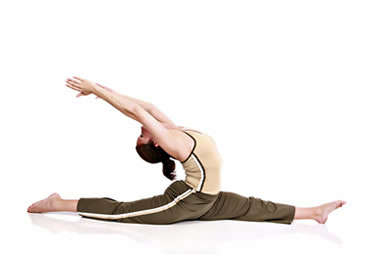|
Do you ever get tired of hearing people say that no excuse is a good excuse? If you aren’t exercising as consistently as you'd like to, it could be because you have some real obstacles—not just excuses—holding you back. So what should you do when you really can’t exercise? Here are three, get-started-now action steps to help you overcome some serious fitness obstacles. Exercise Obstacle #1: You literally don’t have a second to spare.Yes, some people are too busy to exercise. But is there any hope? Of course there is. Action Step #1: Reframe Your Definition of ‘Exercise’ We’re guessing you may have a second or two (you are reading this post, aren’t you?), but there are some days when squeezing in a real workout is truly impossible. On those totally time-crunched days, you may need to redefine what exercise really means. Remember, you don’t have to be in workout clothes to be active! Back in the day, when people worked the land and had active lifestyles, there was no need for separate "exercise." It was just all in a day’s work. Can you make exercise part of your day’s work? Look for ways to work your body as much as possible during your day (carrying children, loading the car, cleaning) -- anything that involves you moving your body counts. Action Step #2: Be Extra Diligent With Your Diet Exercise is important for a healthy body and extra calorie burning (for weight management), but on days when you know you don’t have time for a workout, being extra diligent with your diet is key to staying on track with your weight-loss goals. On average, a 30-minute workout burns only about 250-300 calories (depending on your weight), so on non-exercise days, focus on simple ways to eat healthier and cut back your calorie intake to keep maintaining or losing weight. Action Step #3: Stand As Often As You Can What’s one of the easiest ways to burn more calories all day long without having to break a sweat? Stand up! You’ll engage more muscles and burn almost twice as many calories as sitting. Some studies show that we are sitting as much as 56 hours a week (typical for many office workers!) can seriously hurt your health. In fact, a study from Northwestern University found that even women who exercise regularly sit just as much as those who don’t, making them just as prone to prolonged sitting-related diseases such as diabetes, cancer, cardiovascular disease and even obesity. Just can’t stand up as often as you need to at the office? Try chair marching instead! No one will know you are moving but you, and you can keep typing away at your computer. Exercise Obstacle #2: You are absolutely exhausted.They say exercise boosts your energy levels, but what if you are too tired to even begin moving? Action Step #1: Get To The Root Of Your Exhaustion The truth is, exercise can only offer very limited benefits if you are stressed and tired, which is why it’s important to pinpoint exactly why you are so tired before you even think of trying to work out. Are you trying to fit in too much? Eating too many processed foods? Not sleeping enough? All of the above? Create a plan to permanently remedy the cause of your fatigue by making a conscious effort to get enough quality sleep, improve the quality of your diet (by eating as much fresh stuff as possible) and pare down unnecessary activities (don’t be afraid to ask for help!) to conserve your energy. Action Step #2: Take a Power Nap If you are just too tired to even begin to think about working out, take a power nap instead. Exercising when you are drained can be a fruitless endeavor and could even put you at risk for injury. Instead, take a brief, 15-20 minute power nap to recharge. But avoid the urge to sleep longer; most experts recommend sleeping no more than 20 minutes during the day to avoid waking up feeling groggier or interrupting your evening sleep schedule, so set your alarm! Action Step #3: Do Some Gentle Movement After your power nap, try up to 30 minutes of some soothing, gentle movement such as Tai Chi, Qi Gong or gentle yoga to help replenish your body and restore your energy levels. Obstacle #3: You are injured or working with physical limitations.When you physically cannot exercise—or move much without limitations or pain—it can be tough to know where to start or whether exercise is even good for you. Action Strategy #1: Talk with Your Health Care Specialist First things first: Determine exactly what is (and is not) safe for you to do based on your current situation. Never attempt to exercise with an injury unless you’ve received your doctor’s clearance first. You may find that you aren’t as limited in what you can do, and your doctor or physical therapist may have some great suggestions on how to stay active with your specific injury. Action Strategy #2: Get Creative Once you’ve gotten your doc’s OK to move safely, brainstorm some creative ways to work out with your personal limitations. In some cases, Pilates or aquatic exercise may be appropriate, and actually very beneficial to your recovery. Or, if you are more limited with your lower body mobility, for example, it may be the perfect time to focus on building your upper body strength training, chair yoga or other seated workouts. Action Strategy #3: Focus on What You Can Do for Someone Else Sure, it can be a big bummer when you aren’t able to stick to your typical workout routine because of an injury. But don’t let that discourage you, and try not to feel sorry for yourself! The best way to stay active and feel better about your current situation is to lend a hand to someone else. Think about ways you can offer your time to others. Could you spend some time visiting with patients at a nursing home? Help out at a soup kitchen? Maybe even simply teach a neighbor how to knit or sew? Sharing the gift of your time and presence with someone else can help you stay in good spirits (and even moving) when sidelined with an injury. |
Popular EntriesMore From SparkPeople |

















.jpg)

